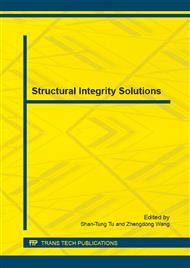[1]
H.T. Nguyen, Q.T. Chu, S.E. Kim. Fatigue analysis of a pre-fabricated orthotropic steel deck for light-weight vehicles J. Journal of Constructional Steel Research. 67(4) (2011) 647-655.
DOI: 10.1016/j.jcsr.2010.11.015
Google Scholar
[2]
Q. G. Wang. Latest advances and developments in aluminum shape casting J. China Foundry. 10(1) (2013) 43-49.
Google Scholar
[3]
M. Carboneras, L. S. Hernández, J. A. del Valle, et al. Corrosion protection of different environmentally friendly coatings on powder metallurgy magnesium J. Journal of Alloys and Compounds. 496(1-2) (2010) 442-448.
DOI: 10.1016/j.jallcom.2010.02.043
Google Scholar
[4]
Y. Xu, J. Kang, T. Huang , et al. Thermal Stresses in a Cylinder Block Casting Due to Coupled Thermal and Mechanical Effects J. Tsinghua Sceince and Technology. 13(2) (2008) 132-136.
DOI: 10.1016/s1007-0214(08)70023-3
Google Scholar
[5]
H. Yamagata, W. Kasprzak, M. Aniolek, et al. The effect of average cooling rates on the microstructure of the Al–20% Si high pressure die casting alloy used for monolithic cylinder blocks J. Journal of Materials Processing Technology. 199 (2008).
DOI: 10.1016/j.jmatprotec.2007.10.023
Google Scholar
[6]
J. L. Cavazos, R. Colás. Quench sensitivity of a heat treatable aluminum alloy J. Materials Science and EngineeringA. 363(1-2) (2003) 171-178.
DOI: 10.1016/s0921-5093(03)00616-6
Google Scholar
[7]
P. Barsanescu, P. Carlescu. Correction of errors introduced by hole eccentricity in residual stress measurement by the hole-drilling strain-gage method J. Measurement. 42(3) (2009) 474-477.
DOI: 10.1016/j.measurement.2008.09.002
Google Scholar
[8]
J. W. Kim, D. G. Lee. Measurement of residual stresses in thick composite cylinders by the radial-cut-cylinder-bending method J. Composite Structures. 75 (2006) 261-266.
DOI: 10.1016/j.compstruct.2005.07.020
Google Scholar
[9]
K. Masláková, F. Trebuňa, P. Frankovský, et al. Applications of the Strain Gauge for Determination of Residual Stresses using Ring-core Method J. Procedia Engineering. 48(10) (2012) 396-401.
DOI: 10.1016/j.proeng.2012.09.531
Google Scholar
[10]
R. Gou, Y. Zhang, X. Xu, et al. Residual stress measurement of new and in-service X70 pipelines by X-ray diffraction method J. NDT & E International. 44(5) (2011) 387-393.
DOI: 10.1016/j.ndteint.2011.03.003
Google Scholar
[11]
P. Angerer, W. Artner, E. Neubauer, et al. Residual stress in spark-plasma-sintered and hot-pressed tantalum samples determined by X-ray diffraction methods J. International Journal of Refractory Metals and Hard Materials. 26(4) (2008) 312-317.
DOI: 10.1016/j.ijrmhm.2007.08.002
Google Scholar
[12]
R. C. Wimpory, M. Boin. Emphasizing the accuracy of the uncertainty of residual stress determination using neutron diffraction J. Procedia Engineering. 10(8) (2011) 1639-1644.
DOI: 10.1016/j.proeng.2011.04.274
Google Scholar
[13]
M. Kashefi, A. Rafsanjani, S. Kahrobaee, et al. Magnetic nondestructive technology for detection of tempered martensite embrittlement J. Journal of Magnetism and Magnetic Materials. 324(23) (2012) 4090-4093.
DOI: 10.1016/j.jmmm.2012.07.029
Google Scholar
[14]
A. Karabutov, A. Devichensky, A. Ivochkin, et al. Laser ultrasonic diagnostics of residual stress J. Ultrasonics. 48(6-7) (2008) 631-635.
DOI: 10.1016/j.ultras.2008.07.006
Google Scholar
[15]
H. T. Lee, C. Liu. Optimizing the EDM hole-drilling strain gage method for the measurement of residual stress J. Journal of Materials Processing Technology. 209(15-16) (2009) 5626-5635.
DOI: 10.1016/j.jmatprotec.2009.05.028
Google Scholar
[16]
L. Álvarez, C. J. Luis, I. Puertas. Analysis of the influence of chemical composition on the mechanical and metallurgical properties of engine cylinder blocks in grey cast iron JComposite Structures. 153(10) (2004) 1044.
DOI: 10.1016/j.jmatprotec.2004.04.222
Google Scholar
[17]
S. M. Yoo, Y. S. Cho, C. C. Lee, et al. Optimization of Casting Process for Heat and Abrasion Resistant Large Gray Iron Castings J. Tsinghua Science & Technology. 13(2) (2008) 152-156.
DOI: 10.1016/s1007-0214(08)70027-0
Google Scholar
[18]
N. Hasebe, C. Bucher, R. Heuer. Heat conduction and thermal stress induced by an electric current in an infinite thin plate containing an elliptical hole with an edge crack J. International Journal of Solids and Structures. 47(1) (2010) 138-147.
DOI: 10.1016/j.ijsolstr.2009.09.023
Google Scholar
[19]
A. Çetin, and A. Kalkanli. Numerical simulation of solidification kinetics in A356/SiCp composites for assessment of as-cast particle distribution J. Journal of Materials Processing Technology. 209(10) (2009) 4795-4801.
DOI: 10.1016/j.jmatprotec.2008.12.007
Google Scholar
[20]
M. Merlin, G. Timelli, F. Bonollo, et al. Impact behaviour of A356 alloy for low-pressure die casting automotive wheels J. Journal of Materials Processing Technology. 209(2) (2009) 1073, (2009).
DOI: 10.1016/j.jmatprotec.2008.03.027
Google Scholar


